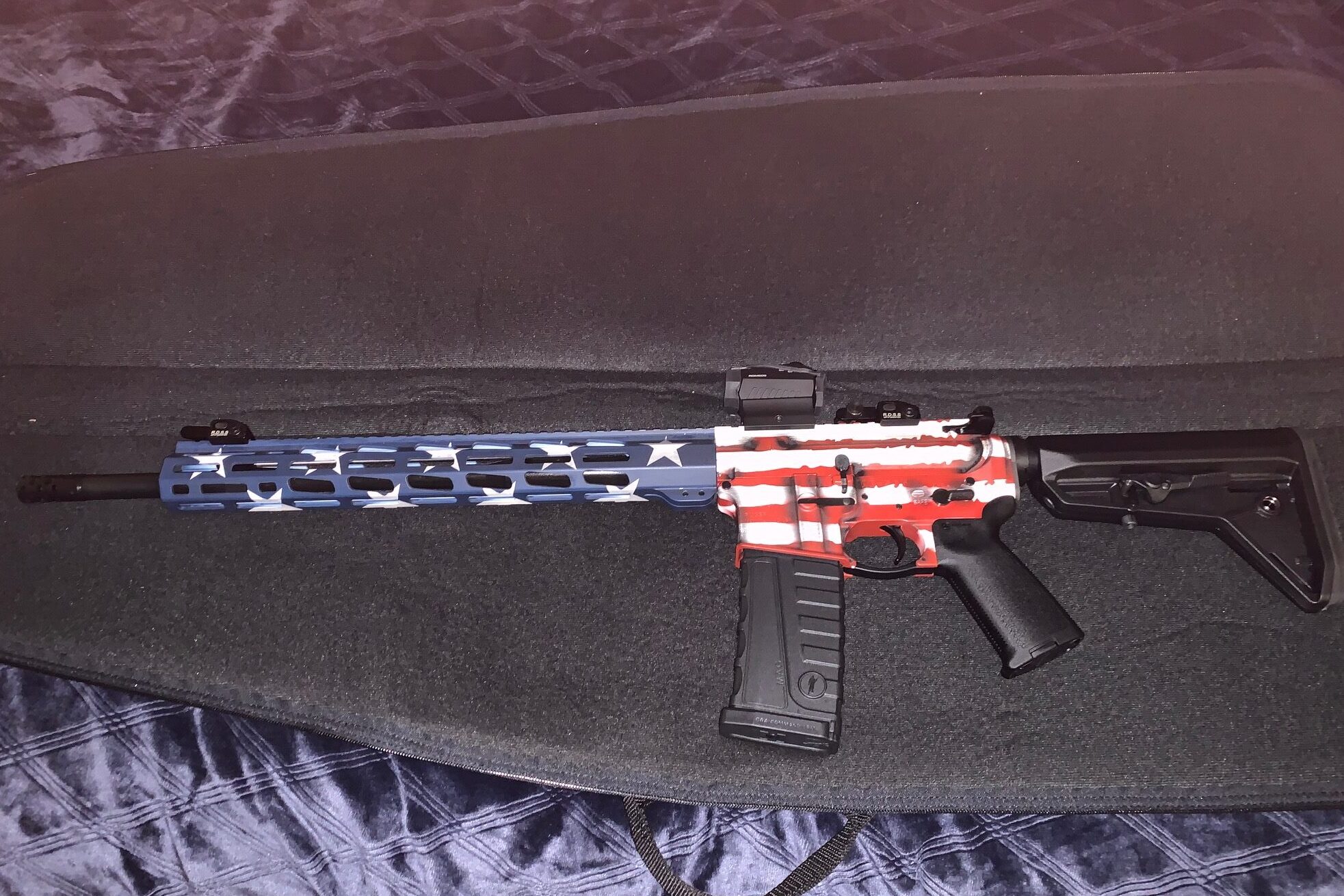Gun guys get a dreamy look in their eyes when you mention the iconic gun of the current era: the AR-15. AR is short for “ArmaLite Rifle,” not, as the mainstream media would have you believe, “Assault Rifle.”
The AR-15 style rifle is a lightweight modular semi-automatic rifle similar to the military M16 and M4 Carbine rifles but lacking their automatic modes. Because its components are interchangeable and widely available, this is a popular gun to build yourself. It is known for its light recoil, high capacity magazine, and easy trigger pull.
The History of the AR-15
Like the “57” in “Heinz 57,” the number 15 refers to the fact that the AR-15 was the fifteenth iteration of this gun that finally made it into production.
Armalite sold the patent and trademarks to Colt in 1959, and Colt retained the trademark when the patent ran out in 1977, so the correct designation for this type of gun is AR-15 style rifle if it is manufactured by anyone but Colt.
Between 1994 and 2004 some varieties were classified as “assault weapons” and were illegal under the Public Safety and Recreational Firearms Use Protection Act.
Ammunition for the AR-15
The AR can be chambered in multiple calibers, including .223/5.56, .300 Blackout, .22LR, and 9mm. These are simply different lengths and widths. Your AR will use one of these varieties.
The chamber in the barrel determines the size of the bullet.
The .223/5.56 caliber is about the size of a .22LR caliber. The difference is that .223 is a bottleneck cartridge and .22LR is in a straightwall case, with the same diameter all the way down. .223 is rimless and .22LR has a rim.
Because it is lightweight, it is faster than 9mm ammunition –over 3000 feet per second. (A mile is 5,280 feet, so that’s over half a mile in one second!) The extra speed provides ballistic advantage for stopping power.
The .300 Blackout cartridge is in a bottleneck case, with a shoulder to make the case wider than the bullet to fit more powder. It is rimless.
The .300 Blackout is a hunting round because its bigger size gives it more stopping power for bigger animals.
A 9mm cartridge is less expensive than other calibers and has a bigger bullet, making it useful for plinking and target practice. It is rimless and straightwall.
A magazine usually holds thirty rounds. My husband informs me that there is no need to walk around the forest like Rambo with a strip of bullets around your neck, because the AR is magazine fed. Rambo had a belt-fed machine gun, not an AR.
What the AR-15 Looks like
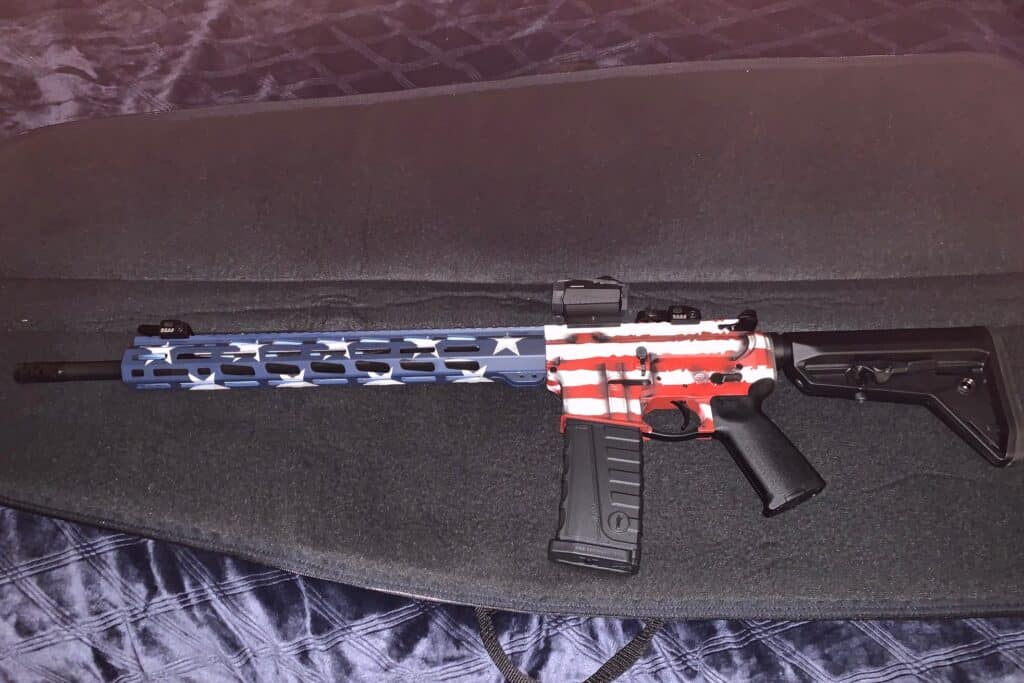
The AR has a distinctly militaristic look that appeals to the serious gun guy. The handguard is full of holes to let air circulate around the barrel and to provide attachment points for accessories.
Popular accessories include
- lights
- lasers
- grips
- sling adapters
The sling goes over your shoulder to carry the rifle. The buttstock can be a fixed length or adjustable to fit the rifle to the length of your arms.
How the AR-15 Works
- You pull the trigger
- The trigger pull releases the hammer
- The hammer hits the firing pin
- The firing pin hits the primer in the cartridge
- The primer sets off the powder charge in the cartridge
- The powder charge triggers the expansion of gases in the case
- The expanded gases force the exit of the bullet from the barrel
- The bullet passes the gas port
- Some of the expanding gases are siphoned off
- The siphoned gases are fed through the gas tube
- The gases enter the gas key mounted on the bolt carrier group (BCG)
- This causes the bolt carrier group to retract
- The retraction pulls out the fired case
- The bolt carrier group moves to the rear into the buffer tube
- The buffer spring is fully compressed
- The bolt carrier group is forced back toward the chamber
- The bolt passes over the top of the magazine
- The bolt strips the next round off the magazine and into the chamber
- The rifle is ready to be fired again.
The Components of an AR-15
Now the fun begins. Get out your Christmas list because the AR-15 can keep a serious gun enthusiast happily immersed in a parts list.
Gun guys like the AR-15 style rifle because they can assemble one themselves with a variety of stock parts. It’s like Legos for grownups!
Upper Receiver
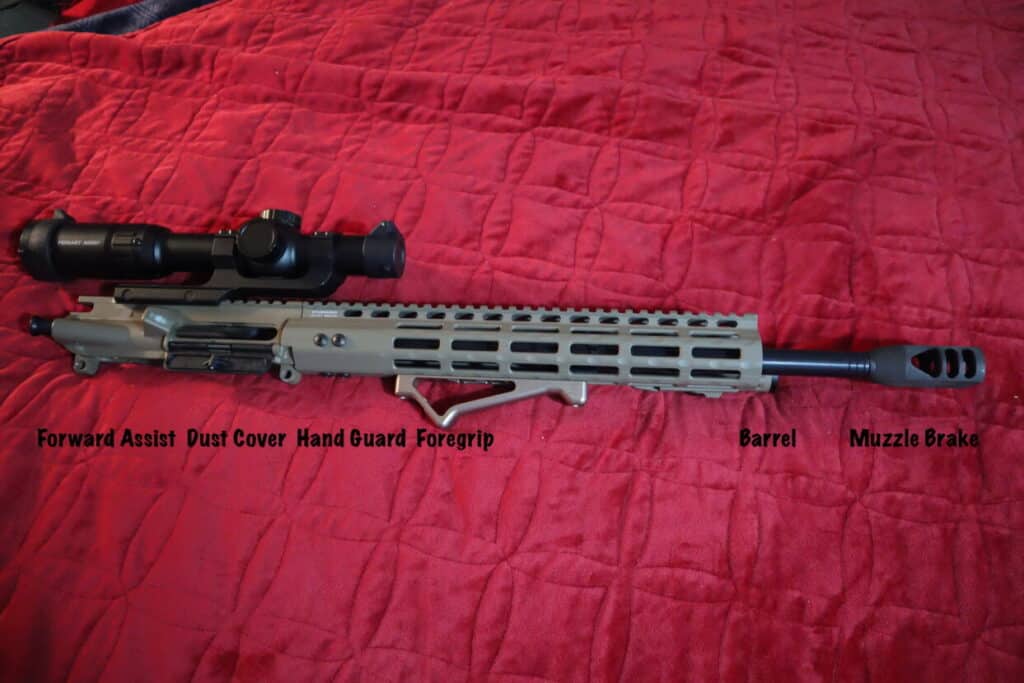
Assembly starts with the upper receiver. The receiver is the part of any rifle or shotgun that contains the working components. The upper receiver extends from just in front of the buttstock to just behind the barrel.
The upper receiver attaches to the lower receiver with two removable pins. Sliding these pins out allows the owner to clean or repair the gun by separating the upper and lower receiver.
Sliding out only the rear take-down pin will open the receiver by rotating it as a hinge around the forward takedown pin. This allows a more limited basic cleaning.
The upper receiver contains the bolt carrier group, the charging handle, the ejection port and the forward assist. The hand guard and barrel attach to the upper receiver. The upper receiver holds the gun together.
You mount your rear sight on the upper receiver and the front sight on the hand guard. It has the ejection port cover (dust cover) attached to it. The gas tube extends into the upper receiver and into the bolt carrier group.
Forward Assist
The forward assist is the piece on the right side of the upper receiver that comes out at an angle. Its function is to push the bolt carrier group forward if it does not go fully into battery (alignment).
There are teeth on the side of the bolt carrier. When you press the forward assist the end of it catches one of the teeth and pushes the bolt carrier group into battery.
Bolt Carrier Group: gas key, bolt carrier, firing pin, bolt, extractor
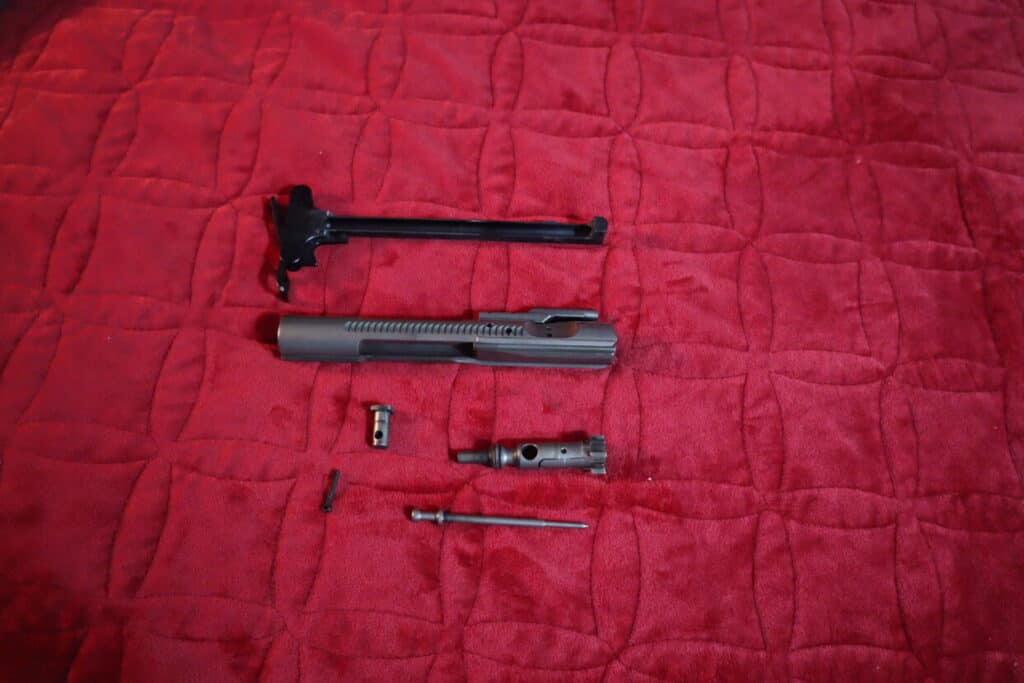
The top item above is the charging handle, which manually cycles the bolt carrier group. The next item down is the bolt carrier, which houses the firing pin and bolt, which make the gun fire and cycle correctly.
Attached to the bolt carrier on the top right is the gas key, which redirects gases to the piston chamber to retract the bolt. Directly below the bolt carrier is the bolt, which inserts into the end of the bolt carrier.
The bolt strips the next round from the magazine to ready the gun for the next shot. The extractor is built into the bolt. It holds the case of the round in place and flips it out of the ejection port after you shoot.
To the left of the bolt is the pin that inserts into the hole in the body of the bolt to keep it in the bolt carrier. This is called the bolt cam pin.
To the left of the cam pin is the retaining pin. The retaining pin inserts into a small hole in the bolt carrier and engages the notch at the rear of the firing pin. It keeps the firing pin from blowing out of the back of the bolt carrier when you shoot.
At the bottom is the firing pin, which strikes the primer to set off the powder charge.
Inside the hand guard is the gas tube. The gas tube goes inside the gas key. When you fire the rifle, gas is released through the barrel, with some of it escaping from a hole in the barrel called the gas port.
The escaping gas is funneled back through the gas tube into the gas key which causes the bolt to go backward. This extracts the spent round and loads the next one.
As the bolt carrier group goes backward, the extractor ejects the spent round. It grabs it around the base of the case and ejects it out the ejection port.
As the bolt carrier group goes back it goes into the buffer tube. When it goes into the buffer tube it compresses the buffer spring. Once the bolt reaches full compression of the spring it starts to move forward. As it goes over the magazine it strips the next round off the magazine and pushes it into the chamber.
Charging Handle
The charging handle is what pulls the bolt carrier group back to initially cock the gun. It has a lever on it that catches the side of the upper receiver to keep it locked in place.
Depending on the style of the gun, the charging handle can have a lever just on the left or be ambidextrous with a lever on each side.
The ambidextrous charging handle is useful so that you can just use your shooting hand to cock it without having to reach all the way over the top of the gun, where the scope will be in the way.
Barrel
The barrel attaches to the upper receiver and is covered by the hand guard. Its end is threaded so you can attach a muzzle brake or flash hider or compensator. You can’t have all three because they go in the same place.
The barrel can have several different profiles: slim with a lightweight barrel or thicker with a heavier barrel.
A thinner barrel is lighter and will dissipate heat more quickly, but a heavier barrel is more durable and withstands the heat longer. The heavier barrel gives you more weight to carry.
Profile options include
- pencil: light and thin
- A2: a little heavier past the gas block
- M4: thicker and heavier beyond the gas port, designed to be used with a grenade launcher
- Government profile: widens after the gas port
- Heavy: starts thicker and narrows at the end
Rail System
The rail system is mounted on the hand guard for the purpose of attaching sights or a scope. Depending on the hand guard, you may have rails on all four sides.
Hand Guard
The hand guard is what goes around the barrel and gives you places to mount accessories such as foregrips, flashlights, lasers, bipods, and pieces of accessory rail to mount other things to. The openings in the hand guard allow heat to dissipate from the barrel.
Ejection Port Cover
The ejection port cover, also called a dust cover, closes the ejection port on the side of the upper receiver to keep dirt and debris out of the inner workings of the upper receiver.
Gas Block
The gas block mounts on the barrel over the gas port (a hole in the barrel). As the gases go down the barrel, the gas port siphons off some gases through the gas block into the gas tube to start the process of cycling the action.
Gas Tube
The gas tube runs from the gas block back to the gas key on the bolt carrier group. This is what the gas goes through to get to the upper receiver to cycle the action.
The length of the gas tube is dictated by the length of the barrel and where the gas port is located on the barrel. Gas tube lengths break down into three categories: pistol length, carbine length, and rifle length. Barrel lengths can be anywhere from 8 to 22 inches.
Compensator
The compensator reduces muzzle rise by redirecting exiting gases upward.
Muzzle Brake
The muzzle brake can attach to the end of the barrel. It helps to lessen felt recoil by redirecting the exiting gases.
Flash Hider
When the gun shoots and the gases explode out the end, the muzzle flash is the burning powder coming out the end of the gun. The flash hider decreases the visual effect of the flash.
Foregrip
The foregrip is mounted underneath the hand guard and can be different shapes: vertical, angled like a pistol grip, or handstop, a flatter piece that you butt your hand up against. The foregrip gives you a place to hold without having to hold the hand guard. It’s like an extra handle at the front.
Lower Receiver

The lower receiver is the part considered by the government to constitute a gun and must be transferred through a federally licensed firearms dealer. The rest of the parts can be bought directly in a mix and match fashion to help build a gun that is uniquely your own.
Buffer Tube
The buffer tube contains the buffer and buffer spring. The buttstock mounts onto the buffer tube. If you have an adjustable buttstock the buffer tube has various stops to allow the buttstock to slide back and forth.
Buffer
The buffer is a weighted metal part that helps keep the bolt carrier group from slamming back too hard. It buffers the recoil. It is surrounded by the buffer spring to absorb the recoil.
Buttstock
Buttstocks can be fixed, or adjustable so that you can adjust the length of pull. Configurations range from a minimalistic hook for your shoulder to a hinged storage container situated on the back of your gun.
The buffer tube is the attachment point for the buttstock.
Trigger Assembly
The lower receiver holds the trigger assembly, which includes the hammer. The trigger assembly can be made of individual parts or it can be a drop-in assembly with everything contained within a sealed cover.
The drop-in trigger has all the parts of the trigger group together so you don’t have to line up the hammer and the springs. Most lower end or entry level ARs will have separate parts. More expensive ARs will use drop-in triggers for a smoother, better functioning gun.
Pistol Grip
The pistol grip mounts to the bottom of the lower receiver to give you a way to hold the gun. It can have openings in the bottom to hold spare batteries or other small accessories.
You can change out the pistol grips with various shapes to fit your hand better. Some are hard plastic and others are more rubbery.
Magazine
The magazine holds the cartridges. It inserts into the magazine well in the bottom of the lower receiver. You can get 30 round or 40 round magazines. With some calibers you can even get a hundred round drum.
How An AR-15 Differs from a Machine Gun
An AR-15 is a semi-automatic rifle that can only fire one bullet for each pull of the trigger. The machine gun is a fully automatic rifle which can fire multiple bullets with a single press of the trigger.
Unlike the AR-15, machine guns have selective fire. The machine gun user can choose from single shot, three-round burst, or full auto modes.
AR-15s are legal to own without any special permission from the government, whereas machine guns are highly regulated and require a special license.
The machine guns that are legal for individuals to own cannot have been made after 1986 due to a law passed that year.
Why the Anti-Gun Lobby Gets So Upset About Semi-Automatics
AR-15s are scary looking and have a militaristic look that fits perfectly into the anti-gun narrative that is so prevalent in Washington, D.C. The AR-15 makes an excellent prop for the lawmakers who make an issue of high-capacity magazines.
The term “assault rifle” was manufactured by the liberal left to suggest that gun enthusiasts are bent on attacking their fellow Americans at every opportunity. Joe Biden insists that you don’t need 30 rounds to kill a deer.
The point I have to make in the face of these arguments is that it is not the government’s place to decide whether I can have a gun that looks scary and shoots more than two rounds.
The Second Amendment sets up the expectation that the American public must be able to hold the government in check. Our Founders knew firsthand the dangers of government overreach.
Your scary looking rifle might be the thing that keeps an authoritarian government from visiting you in the middle of the night to change your address because you said something that didn’t suit the governor of your state.
What It’s Like to Shoot an AR-15
Most ARs have very light recoil because the gas port in the barrel vents back into the chamber to cycle the bolt carrier group. A buffer in the buttstock absorbs some of the recoil.
When I shot my husband’s Ruger AR- 556, I found the trigger pull easy and the recoil close to nil. It was loud because of the extra powder in the cartridge.
The AR-15 That My Husband Built With Individual Components
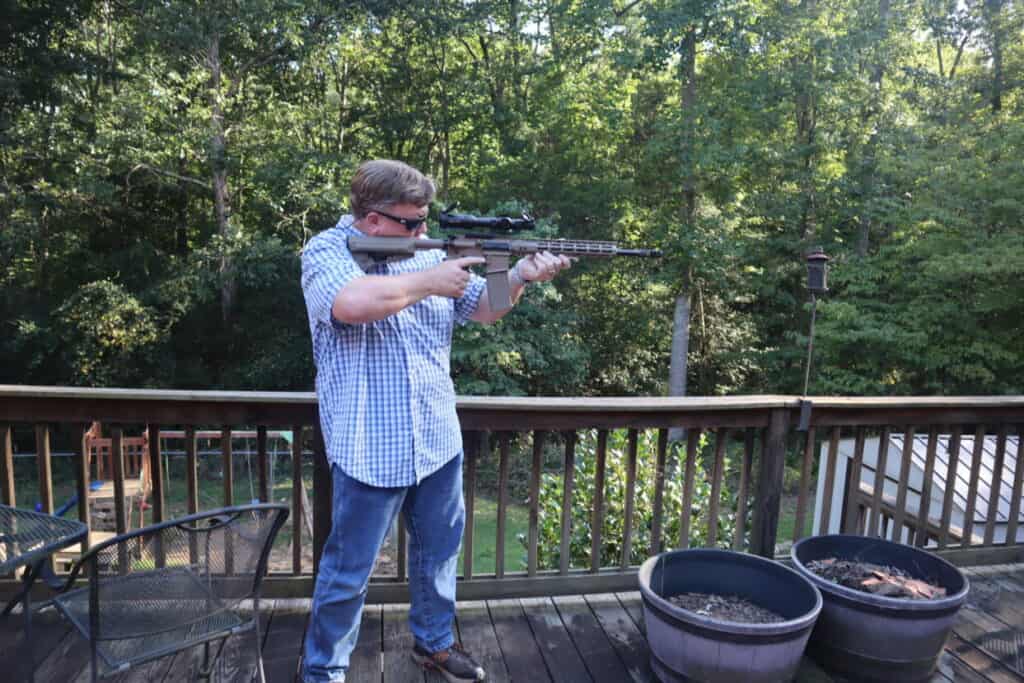
When Chris built an AR-15 style rifle, he found the components online. He ordered the upper and lower receiver from Aero Precision because of the good reputation of the company. The upper receiver has an adjustable screw to prevent play in the mating of the upper and lower receiver.
He went with a Magpul adjustable buttstock with a couple of storage compartments built in for accessory storage.
He chose a Stark pistol grip because it has a sling swivel stud made into it for another attachment point for the sling.
He picked a Faxon barrel because it is a good quality barrel. He inserted a muzzle brake on the end of the barrel to help mitigate muzzle rise and lessen recoil.
He installed an ambidextrous charging handle so he can work it from either side to avoid reaching over the scope.
He used an M-lok style of hand guard that is lighter and has rectangular holes because he did not think he would like the key mod with its key-shaped attachment points.
He chose .300 Blackout ammunition instead of .223 because he wanted a heavier round for more stopping power.
If you know a gun guy who has been very, very good this year, he would like it if you bought him an AR-15 for Father’s Day. Or Arbor Day. Or just because.


